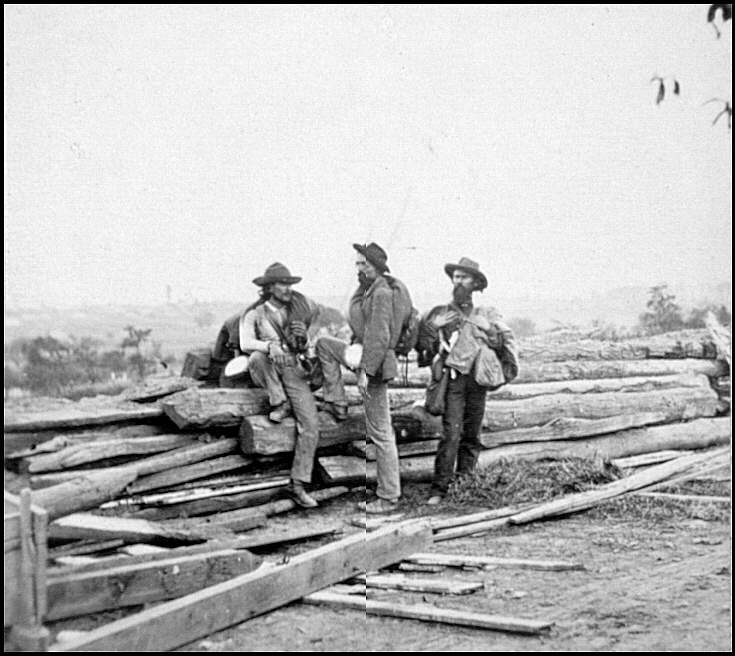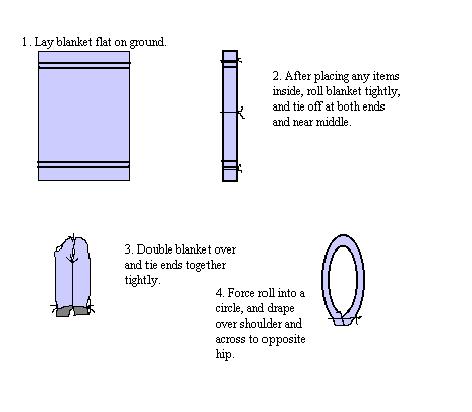
At
the beginning of the Civil War, every volunteer and regular had, or tried
to acquire, a knapsack. In or on the knapsack went such necessities as
a blanket or two, a clean shirt, socks, gloves, shaving kit, and the other
items of civilization and home. After the first grueling marches, however,
many soldiers in both armies quickly did away with anything that wasn't
absolutely necessary. One of the casualties, particularly among the citizen
soldiers in the militia, was the knapsack. To take its place, there was
the bedroll.
The
bedroll basically consisted of one blanket, tightly rolled up into a cylinder,
which was then doubled over, bound together at the ends, and worn over
the shoulder. In some cases, a tin cup or mucket was tied to the end of
the bedroll.

Confederate Prisoners at Gettysburg, 1863.
The
photo above shows three captured Confederate soldiers after the battle
of Gettysburg. Each soldier has a bedroll, which had become quite common
by this time. The blankets appear to be of heavy wool, to judge by the
size of the rolls.
Again,
looking closely at the photo, one sees that there are several variations
in the manner in which the blankets are secured. The soldier on the right
has the blanket tied off at the ends only, with the result that the middle
of the blanket has unrolled slightly. The other two soldiers appear to
have more securely rolled blankets.
For
our purposes, the bedroll should consist of one blanket, rolled lengthwise.
The ends should be tied together with a length of string or leather lace,
in order to create a "hoop". The use of a third lace near the middle will
help hold the roll together while being worn over the shoulder. There is
also the variant method of leaving a length of cord between the ends of
the roll, to allow more freedom of movement. This is particularly useful
if your bedroll is shorter than usual. You can roll your gum blanket up
with the blanket, or carry it separately, depending on the weather. Another
option is to drape the gum blanket over the uniform belt.
Personal
items may have been, and most likely were, tucked away in the bedroll.
Food, however, probably was not. Many, if not most, soldiers carried the
forage bag, popularly called the haversack. The purpose of this item was
to carry one's rations about until eaten. There would be no reason, therefor,
to carry food in the bedroll. Also, the cup could be attached to the belt,
as suggested in some militia drill manuals, or to the buckle of the haversack,
which seems to be the way reenactors like to do it. But one could do this
with one's bedroll, if one wanted (I don't).
Another
thing to consider is that the more one carries inside the bedroll, the
bigger the bedroll becomes. Bigger is not always better when one is trying
to keep his place in line and shoulder or fire a musket. The desire to
keep the diameter of the bedroll as small as possible becomes more obvious
when these factors are considered.
An
alternate hypothesis is that the roll would be tied loosely, so that it
flattened out across the shoulder. The blanket roll could then be draped
across the right shoulder, and the blanket becomes a sort of shooting pad,
absorbing the recoil of firing.
Off
which shoulder to drape the roll is a matter of personal choice. I prefer
to hang it from the left shoulder, which leaves the right shoulder clear
for firing, as well as for many of the positions of the manual of arms.
I also prefer to place the cartridge box through the hoop of the bedroll,
so it rests outside, rather than trapped under the bedroll. This makes
it easier to retrieve the next round while firing, since I don't have the
blanket forcing the box's flap closed while I'm fumbling about looking
for a cartridge. I wish to point out that I have seen no photographs showing
soldiers of the day wearing their cartridge boxes in such a manner, and
so this procedure is not borne out by the historical record.
So,
to conclude, I recommend the following type of bedroll: one wool blanket,
with a pair of clean socks and a clean shirt rolled up inside. Maybe a
writing kit, too. No food (put that in your haversack.) Tie the roll off
at both ends and near the middle, and drape it over your left shoulder,
with the tied end behind the cartridge box.. Take your poncho / gum blanket
and fold it up so you drape it over your belt, around back, out of the
way. If you must, tie your cup to the bedroll, or loop your belt through
the cup handle, and slide the cup beside the poncho, out of the way.
If you don't think you'll need it during the day, you could also roll your
great coat up with your blanket (just remember that the bedroll will get
much larger and heavier if you do).

Notes:
1.
The blanket roll became popular after the first year of the war, although
many soldiers carried the knapsack for some time after. Knapsacks were
more commonly worn by green troops, though.
2.
Many veteran troops dispensed with the greatcoat while on campaign, preferring
to drape the blanket over the head and shoulders, and securing it in place
with the uniform belt and shoulder sling. Greatcoats were welcomed in winter
quarters, however, as either an extra blanket or as a sort of ersatz pillow
for a tired soldier's head.